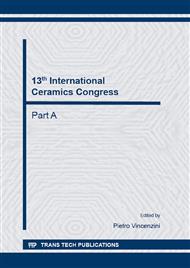p.1
p.6
p.12
p.18
p.24
p.30
p.36
p.42
Structural and Electrical Properties of Ca2+ Substituted Pb[(Zr0.52Ti0.48)0,98(Cr3+0.5, Ta5+0.5)0,02]0,96 P0,04 O3 Ceramics
Abstract:
Pb1-x Ca x [(Zr0.52Ti0.48)0,98(Cr3+0.5, Ta5+0.5)0,02]0,96 P0,04 O 3 (x = 0,00, 0.02, 0.04, 0.06) ceramics were prepared using the conventional mixed-oxide route. The resultant samples were sintered at different temperatures and subsequently characterized in terms of both microstructure and dielectric properties to study the effects of sintering behavior. X-ray diffraction analysis reveals that all specimens are a pure perovskite phase without pyrochlore phase and exhibits a phase transition from a rhombohedral phase to the coexistence of rhombohedral and tetragonal phases with an increase of sintering temperature. The grain size first increases up to x = 0.02 and then decreases. Comparing with the undoped ceramics, the dielectric properties of the Ca-doped PZT–PCTP specimens are significantly improved. The results show that the ceramics sintered at 1180 °C have optimum electrical properties for x= 0.02: a high dielectric constant (εr = 16800) at Tc, a low dissipation factor (tanδ = 0.009) and a low resistivity (ρ= 0.09 ×10+4) (Ω.cm) at 1 kHz, which indicates that the PZT–CCTP ceramics are promising for lead practical applications.
Info:
Periodical:
Pages:
18-23
Citation:
Online since:
October 2014
Authors:
Keywords:
Price:
Сopyright:
© 2014 Trans Tech Publications Ltd. All Rights Reserved
Share:
Citation:


